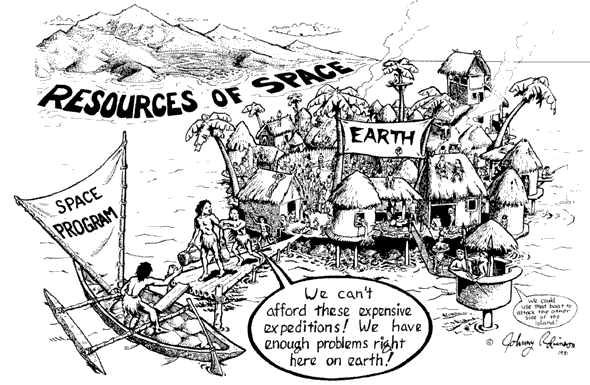The Space Movement:
The Long Run Geopolitics of Space Settlements The Long Run Geopolitics of Space Settlements
The vast majority of the resources of the solar system are in space rather than on the Earth. As I have argued in an earlier column (Ad Astra, Summer 2009), there are enough materials in the solar system to build O’Neill space settlements with a combined land area of one million times the land area of the Earth. Former NASA Administrator Michael Griffin has said, “One day, I don’t know when, but one day, there will be more humans living off Earth than on it” (February 2006). Given the available land area, it is likely that the vast majority of humans in the solar system will eventually live in space. Let’s assume this is true and ask, what are the geopolitical implications?
The average per capita income of someone living in space is likely to be at least as large as someone living on the Earth. Initially settlers will probably be chosen so as to be highly capable. They will all most certainly control a great deal of capital and automated equipment. Consequently, their output per capita will be large and their income will reflect these facts. It is harder to predict what will happen in the more distant future. However, virtually all of the plausible scenarios result in at least some per capita income advantage for the settlers.
If the vast majority live in space and their per capita income is at least as large as those who live on the Earth, it follows that the size of the space economy will be much greater than the Earth economy.
It is generally known that in the long run military power, cultural influence and technical superiority are well correlated with the size of an economy. Thus, space settlers will eventually dominate human solar system civilization in the economic, military, cultural and technological spheres.
To better grasp the enormity of what this means, consider what happened when the Old World (loosely Afro-Eurasia) added the New World (loosely North and South America) to create the first worldwide economy and civilization. The result was profound. Yet the increase in land area of the Old World plus the New World compared to the Old World by itself was only a factor of 1.5 – not one million.
Consider the following thought experiment. Suppose humanity evolved and was contained in the Hawaiian Islands, until ocean transportation technology developed to the point that it was possible to settle non- Hawaiian Islands and later the continents. Once settled, the rest of the world would clearly dominate Hawaiian civilization. Yet the increase in land area of the Earth compared to Hawaii would only be a factor of 30,000 – not one million.
The long run geopolitical difference between the solar system as a whole and the Earth is greater – much greater – than the difference between the Earth as a whole and Hawaii. If the Chinese had colonized the New World rather than the Europeans, then the world today would be profoundly different. For the same reasons, but more so, who leads the space settlement effort will have a profound impact on the future of human civilization. This is a fundamental geopolitical consideration that all those who care about the future of humanity need to take into account.
This article was written by Mark Hopkins, Chairman of the Executive Committee of the National Space Society. The article originally appeared in Ad Astra, Summer, 2010.








